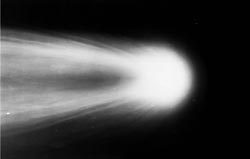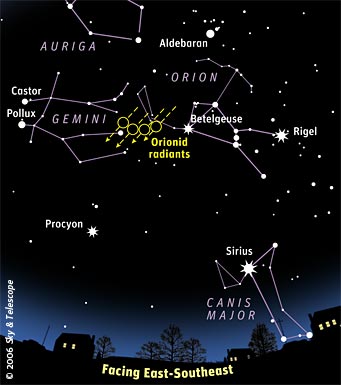This could be a particularly good year for the Orionid meteor shower, which runs from roughly October 17th to 25th with one or more peaks around the morning of the 21st. The Moon is out of the sky during the good meteor-watching hours from midnight to dawn. Moreover, in years past the Orionids have shown a 12-year cycle in their strength — and based on this we should be seeing a bumper crop of Orionids in 2009, with peak rates of up to 30 meteors visible per hour by a single person under ideal observing conditions.

The seething nucleus of Halley’s Comet, as photographed on May 8, 1910, by the 60-inch telescope at Mount Wilson Observatory in California.
Courtesy Carnegie Institution of Washington.
The Orionids have an illustrious parentage. Like the Eta Aquarids of May, they are bits of debris shed long ago by Halley's Comet. The two showers are essentially one and the same; Earth intersects a single, broad stream of meteoroids at two places in its orbit on opposite sides of the Sun.
Like the Eta Aquarids, the Orionids tend to be faint and swift — only the Leonids hit Earth's atmosphere faster — and they often leave briefly glowing trains. The shower is actually a complex of several components with different maxima spread over several days. These radiants (the points in the sky from which the meteors appear to radiate) are grouped near Orion's Club, as shown on the accompanying chart.

The Orionid meteor shower has several radiants in northern Orion near the feet of Gemini. They all drift about 1° eastward per day (as indicated by dashed arrows) due to Earth’s orbital motion.
S&T: Gregg Dinderman
For observers around 40° north latitude, these radiants rise high in the eastern sky (at least 45° up) by about 2 a.m. daylight saving time. So that's about when the meteor activity gets pretty good. The first light of dawn begins stealing into the east about four hours later.
Halley's Comet last came through the inner solar system in 1985–86, and at that time its nucleus shed a layer of dirty ice about 20 feet (6 meters) thick on average. This has been happening every 76 years for many millennia. During that time the dirt bits have spread all around Halley's elongated orbit and a fair distance from it sideways, which is why some of the particles now intersect Earth even though the comet's orbit does not. (The orbits of Halley and Earth are separated by 22 million km, or 15% of the average Earth-Sun distance, at their closest point.) No one knows how long it took the Orionid meteoroids to drift so far off track — one estimate is 4,000 to 10,000 years — but it's clear that as shower meteoroids go, the Orionids are old.
They've been seen for a long time too. The first known Orionid shower was recorded by the Chinese in AD 288, when "stars fell like rain." The shower has been well observed ever since astronomers first recognized its radiant in 1864.
 7
7









Comments
Mike Olbinski
October 20, 2009 at 1:41 pm
Hey guys,
Just curious...you say the 40 degree latitude...if I live in Phoenix, would I end up looking more East than east-southeast?
Thanks for the heads up, maybe the camera can capture some of these tonight.
Mike
You must be logged in to post a comment.
paul wellar
October 21, 2009 at 6:17 am
I was out observing tonight, and while looking around Auriga I had one blow right through my field of view. It was a real nice one too.
You must be logged in to post a comment.
Kathleen Horner
October 21, 2009 at 7:08 am
Even living in the city (far from the downtown lights)I was able to view about 6 meteors just before 6 am....one lasting nearly 2 seconds...beautiful, orangish color. 6 meteors doesn't sound like much to view, but to see just one is truly an 'ahhh' moment. I'm ready to tackle the day.
You must be logged in to post a comment.
Kathleen Horner
October 21, 2009 at 7:08 am
Even living in the city (far from the downtown lights)I was able to view about 6 meteors just before 6 am....one lasting nearly 2 seconds...beautiful, orangish color. 6 meteors doesn't sound like much to view, but to see just one is truly an 'ahhh' moment. I'm ready to tackle the day.
You must be logged in to post a comment.
Alan MacRobert / S&T
October 21, 2009 at 8:50 am
Mike,
> I'm in Phoenix, would I end up looking
> more East than east-southeast?
The best direction to look is wherever your sky is darkest, which is usually straight up. The shower's *radiant* is the perspective point in the sky where the meteors would all seem to be coming from if you could see them in the far distance. But you can't -- you only see them for the last second(s) of their life, when they hit the upper atmosphere. And this can happen anywhere in your sky.
Alan MacRobert, S&T
You must be logged in to post a comment.
George Olshevsky
October 21, 2009 at 11:57 am
Hi, Kelly--When might we expect a fifth edition of The New Solar System? Just curious, as I've been thumbing through my fourth edition and it got me to wondering.
You must be logged in to post a comment.
Evan James
October 29, 2009 at 2:24 pm
I had a great time searching for meteors in the night sky. I have no light pollution in my area and I remember seeing 3-4 meteors under Orion's belt
You must be logged in to post a comment.
You must be logged in to post a comment.